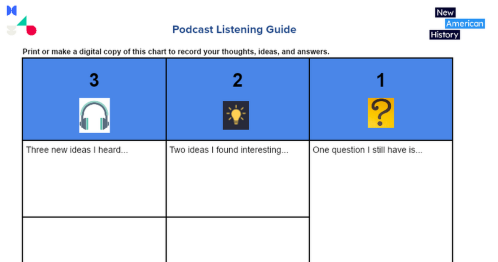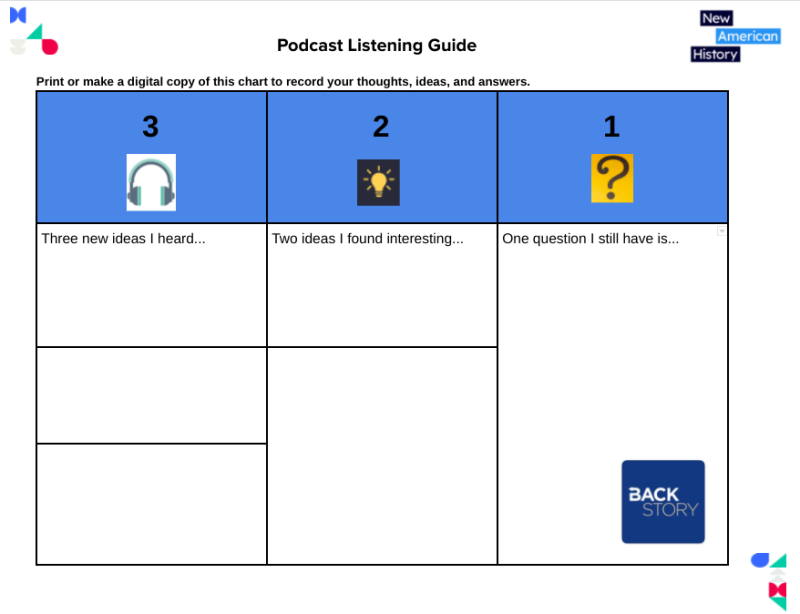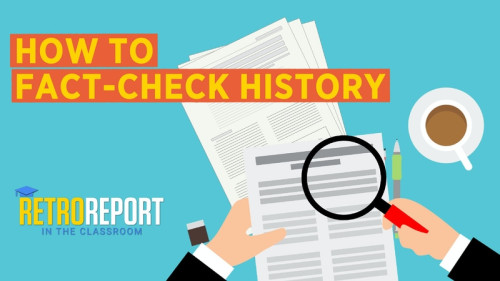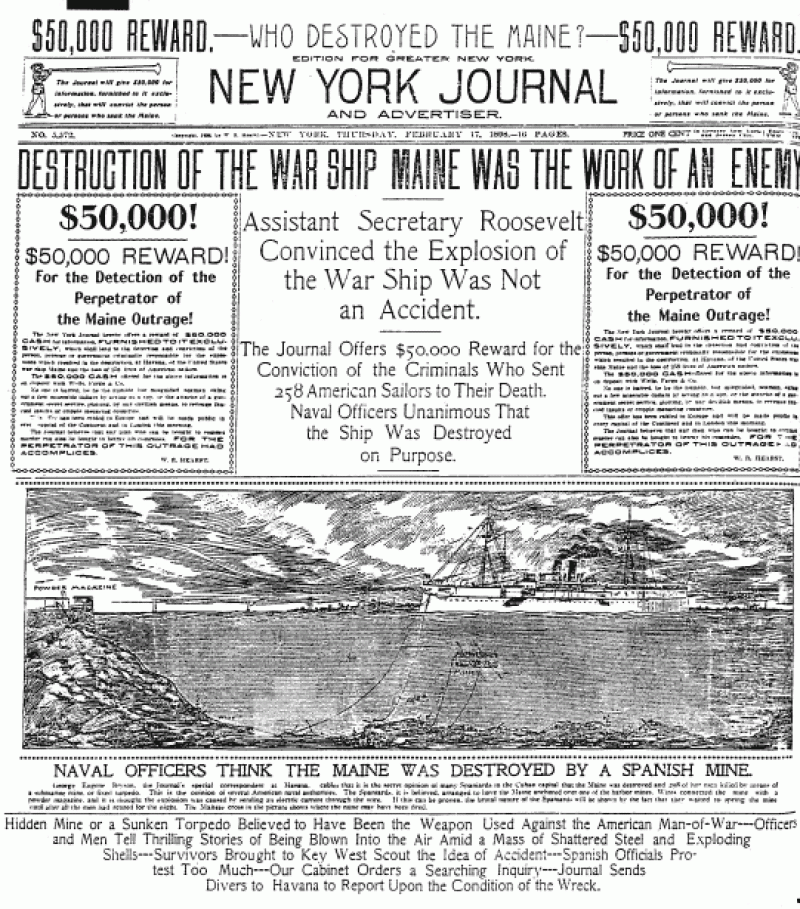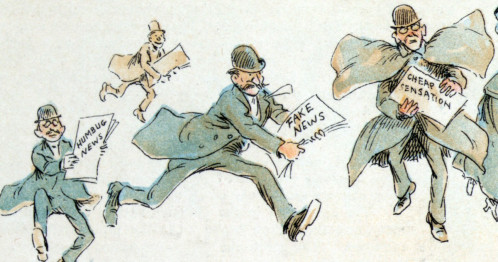This work by New American History is licensed under a Attribution-NonCommercial-ShareAlike 4.0 (CC BY-NC-SA 4.0) International License. Permissions beyond the scope of this license may be available at newamericanhistory.org.
Fake News
View Student Version
Standards
C3 Framework:D2.His.6.6-8. Analyze how people’s perspectives influenced what information is available in the historical sources they created.D2.His.11.9-12. Critique the usefulness of historical sources for a specific historical inquiry based on their maker, date, place of origin, intended audience, and purpose.
National Council for Social Studies:Theme 2: Time, Continuity and Change
National Geography Standards:Standard 18: How to apply geography to interpret the present and plan for the future
Teacher Tip: Think about what students should be able to KNOW, UNDERSTAND and DO at the conclusion of this learning experience. A brief exit pass or other formative assessment may be used to assess student understandings. Setting specific learning targets for the appropriate grade level and content area will increase student success.
Suggested Grade Levels: Middle/High School (6-8, 9-12)
Suggested Timeframe: 2 sessions, 90 minutes each
Suggested Materials: Internet access via laptop, tablet or mobile device, large poster-sized pad or paper or butcher paper, markers, copies of the historic news article used for the Chalk Talk / Big Paper activity.
Key Vocabulary
Alternative Facts - presenting a subjective or fabricated interpretation of the truth to suit one's own political or ideological purposes.
Clickbait - internet content designed to attract attention and encourage visitors to click on a particular website, often to mislead or sell a product.
Fake News - deliberate misinformation spread via traditional news media (print and broadcast), social media, websites intended to look like trusted news sources. Often distributed as propaganda, as satire, or for financial gain.
Media Literacy - the ability to identify, analyze and evaluate different types of media (print, online, broadcast) including the origin and reason the media was created.
Satire - use of humor or exaggeration in order to criticize or show how foolish, wrong, or corrupt some people's behavior or ideas are.
Tabloid - a newspaper comprised mostly of images, stories based on gossip or sensationalized statements designed to increase readership, not usually based on researched facts.
Read for Understanding
Teacher Tips:
It is important for educators to remain non-partisan when discussing politically charged topics. Personal political viewpoints must not be interjected, and lessons should model balanced perspectives and factual analysis. Always view all videos, links, and text prior to assigning to students to make an informed decision about the appropriateness of a resource for your students.
This Learning Resource includes language in the body of the text to help adapt to a variety of educational settings, including remote learning environments, face-to-face instruction, and blended learning.
If you are teaching remotely, consider using videoconferencing to provide opportunities for students to work in partners or small groups. Digital tools such as Google Docs and Google Slides may also be used for collaboration. Rewordify helps make a complex text more accessible for those reading at a lower Lexile level while still providing a greater depth of knowledge.
These Learning Resources utilize collaboration and critical thinking strategies such as Chalk Talk, Big Paper, Turn and Talk, and Gallery Walk.
The Chalk Talk or Big Paper strategy may be used with or in lieu of a Gallery Walk for students to share their thoughts and ideas about Fake News. This usually works better as a tabletop activity rather than students trying to write when the paper is attached to a wall. The "How to Spot Fake News" infographic may be substituted for the one from Project Look Sharp, depending on the students' reading level.
These Learning Resources follow a variation of the 5Es instructional model, and each section may be taught as a separate learning experience, or as part of a sequence of learning experiences. We provide each of our Learning Resources in multiple formats, including web-based and as an editable Google Doc for educators to teach and adapt selected learning experiences as they best suit the needs of your students and local curriculum. You may also wish to embed or remix them into a playlist for students working remotely or independently.
For Students:
Media literacy is an important skill for strengthening content area reading, critical thinking, evaluating credible sources and encouraging participatory citizenship. Students should learn to ask questions and back up answers with factual information as they become smart consumers of products and information.
Engage:
What is “Fake News” and why should we care?
Fake News is not new, but with the explosion of technology in the past few decades, the way we generate, consume and distribute the news has changed and continues to change almost on a daily basis. With these changes come new ways for people to mislead consumers and misrepresent information rapidly to a much larger audience. This video from our friends at Wired explains how Fake News spread rapidly in the 2016 presidential election cycle, and how it continues to influence us today.
Watch this video either as a whole class or individually on your device.
Turn and talk to a partner after you finish viewing the video. If working remotely, use the chatbox or another collaboration strategy such as Google Docs or Google Slides, as recommended by your teacher. Discuss the following:
- Who creates Fake News?
- For what purpose is Fake News created?
- How can we determine if a news source is real or fake?
- Where might we go to find out more information or research is a news item is real or fake?
Your teacher may ask you to record your answers on an exit ticket.
Explore:
How long has Fake News been around, and why are we just now making a big deal about it?
Long before the internet, Facebook and Twitter, there was Fake News. This episode of BackStory gives us some insights into how Fake News has always been a part of our American news cycle. Your teacher may ask you to listen to this as a class, or with headphones/earbuds on a mobile device. While listening, complete the graphic organizer below to help you process your thoughts about Fake News.
Listen to this BackStory episode, "Fit to Print? A History of Fake News"
Download the podcast listening guide. Print or make a copy of this chart to record your thoughts, ideas, and answers.
Turn and talk to a partner. If working remotely, use the chatbox or another collaboration strategy such as Google Docs or Google Slides, as recommended by your teacher:
- Do Penny Papers still exist today?
- Who might be the Founding Father of Fake News?
- Were Penny Papers all bad?
- Is journalism “old fashioned” or still relevant/important today?
Your teacher may ask you to record your answers on an exit ticket.
Explain:
How can we learn to spot Fake News, and should we still trust the news?
Fake News is not always easy to spot. As consumers of social media, cable news, and a variety of print resources, it is important to develop a critical mindset. Take a look at the graphic organizer from Project Look Sharp.
Next, view this video from our friends at RetroReport to learn more about Fact-Checking History.
The questions used here to evaluate media resources are similar to those historians use when analyzing primary and secondary sources. Practice using this tool or the video to evaluate an article posted in the New York Journal on February 17, 1898, about the sinking of a warship, the USS Maine.
Working in groups, your teacher will assign one or two categories from the graphic organizer or video for each table to respond, using the article and a Chalk Talk or Big Paper strategy.
You may wish to zoom in using your browser (CTRL+) or touch screen, or open this direct link to the image.
Once each group has had a chance to answer the questions for their category or categories, your teacher may choose to have you share them aloud or via a Gallery Walk. Take time to listen to or view your classmates’ ideas and responses.
- Did anyone’s comments change your thinking?
- What comments, if any, reaffirm your ideas?
Your teacher may ask you to record your answers on an exit ticket.
Elaborate:
What is the impact of Fake News on the 1st Amendment and free speech?
After examining the primary source image of the sinking of the U.S.S. Maine, take a few minutes to read this Bunk excerpt (section or passage of a longer written work) about Fake News.
- Thinking about the excerpt, what clues do you see about Fake News as they might relate to the Project Look Sharp graphic organizer or the newspaper image from the New York Journal you examined in the last learning activity?
- Knowing this new information, what might you add to the Chalk Talk or class discussion based on this new information? Did the excerpt you read change your mind about what you previously thought about Fake News of the image from the New Your Journal? Turn and talk to an elbow partner sharing your thoughts on this Bunk excerpt.
- Select a Connections icon, then select the “View Connections” button to the right of the excerpt you read on Bunk. Notice how each icon leads to other excerpts connected to the first one you read on Bunk. Take a few minutes to explore some of the connected excerpts for each icon.
- What do you notice about the tags for these connections? Which excerpts are you most interested in reading more about, and why?
- Select an additional excerpt related to Fake News. Take a few minutes to skim the article. What ideas, if any, might you add to the Chalk Talk based on reading this second excerpt?
- What new tags would you suggest adding to this connection? Add your ideas and tags to the Chalk Talk and share your reasoning with a partner.
Your teacher may ask you to record your answers on an exit ticket.
Extend:
Here is an additional BackStory blog entry on Fake News with additional examples from another historical era.
The News Literacy Project has created tips and tools to use to spot media bias, misinformation, and the ethical use of AI (artificial intelligence).
This blog post from Medium encourages us to think deeply about how we now consume and use data and the media.
- Select one of these resources and write a Reflective Journal about your thoughts on how Fake News impacts our daily lives.
Your teacher may ask you to share your Reflective Journal or record your answers on an exit ticket.
Citations:
“A Century Ago, Progressives Were the Ones Shouting 'Fake News'.” Bunk History. Bunk History, February 2, 2018. https://www.bunkhistory.org/resources/1792.
“Backstoryradio.org.” Backstoryradio.org (blog). Virginia Humanities, August 31, 2018. https://www.backstoryradio.org/shows/fit-to-print.
“Here's How Fake News Works (and How the Internet Can Stop It) - WIRED Videos.” Wired. Conde Nast, February 14, 2017. https://www.wired.com/video/watch/here-s-how-fake-news-works-and-how-the-internet-can-stop-it.
“How to Fact-Check History.” YouTube. Retro Report, December 14, 2021. https://www.retroreport.org/video/how-to-fact-check-history/.
Infographic. How to Spot Fake News. IFLA, n.d. https://upload.wikimedia.org/wikipedia/commons/3/32/How_to_Spot_Fake_News.jpg.
“Key Questions to Ask When Analyzing & Producing Media Messages Handouts.” Project Look Sharp: K-12 & Higher Ed. Media Literacy Lesson Plans: Ithaca College. Project Look Sharp, September 2019. https://www.projectlooksharp.org/?action=medialithandouts.
Leighninger, Matt. “Infogagement: Citizenship and Democracy in the Age of Connection.” Medium. Philanthropy for Active Civic Engagement (PACE), August 18, 2018. https://medium.com/infogagement/infogagement-citizenship-and-democracy-in-the-age-of-connection-cdf849610381.
View this Learning Resource as a Google Doc



